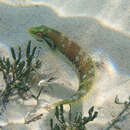en
names in breadcrumbs


The seagrass wrasse, Novaculoides macrolepidotus, is a species of wrasse native to the Indian Ocean and the western Pacific Ocean. It can be found in lagoons and mangrove forests in seagrass beds or on sandy areas with plentiful algal growth. It occurs at depths from the surface to 10 m (33 ft). This species grows to 16 cm (6.3 in) in total length. It can be found in the aquarium trade. This species is the only known member of its genus.[2] The juveniles and smaller adults of this species are Batesian mimics of the venomous waspfish in the genus Ablabys. When threatened, these fish dive headfirst into the sea grass or sea weed beds they inhabit.[3]
The seagrass wrasse, Novaculoides macrolepidotus, is a species of wrasse native to the Indian Ocean and the western Pacific Ocean. It can be found in lagoons and mangrove forests in seagrass beds or on sandy areas with plentiful algal growth. It occurs at depths from the surface to 10 m (33 ft). This species grows to 16 cm (6.3 in) in total length. It can be found in the aquarium trade. This species is the only known member of its genus. The juveniles and smaller adults of this species are Batesian mimics of the venomous waspfish in the genus Ablabys. When threatened, these fish dive headfirst into the sea grass or sea weed beds they inhabit.